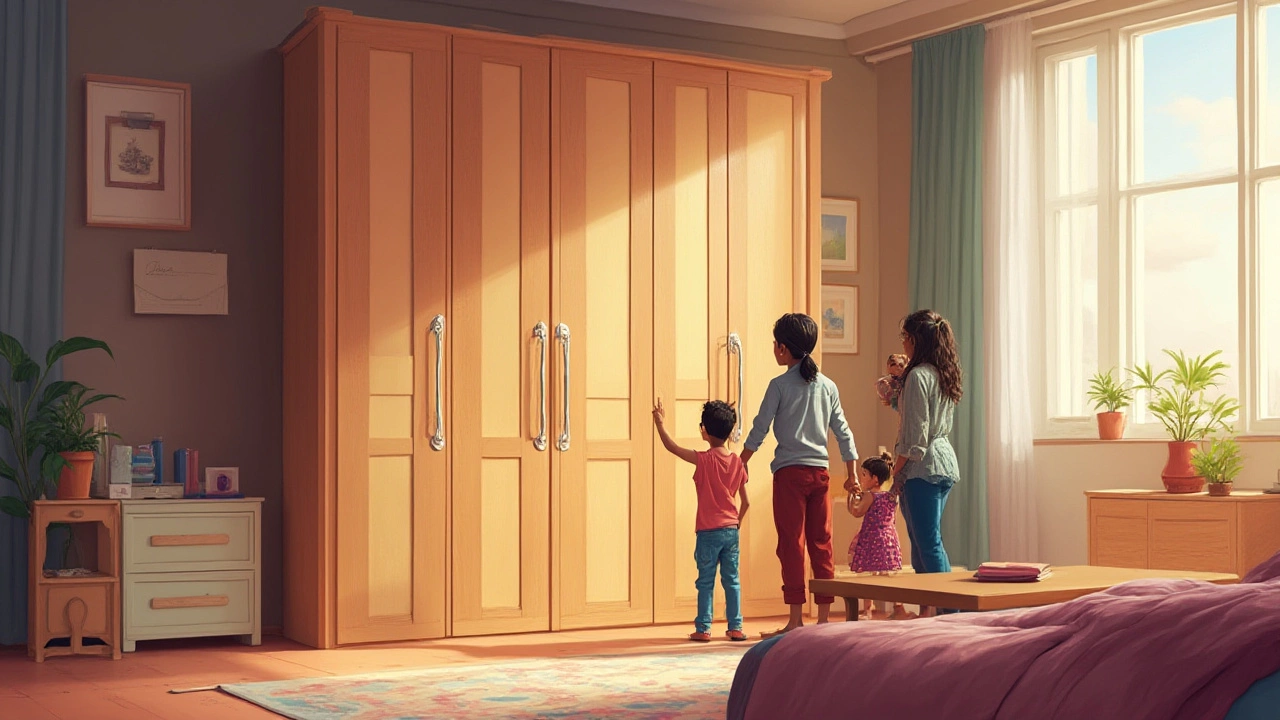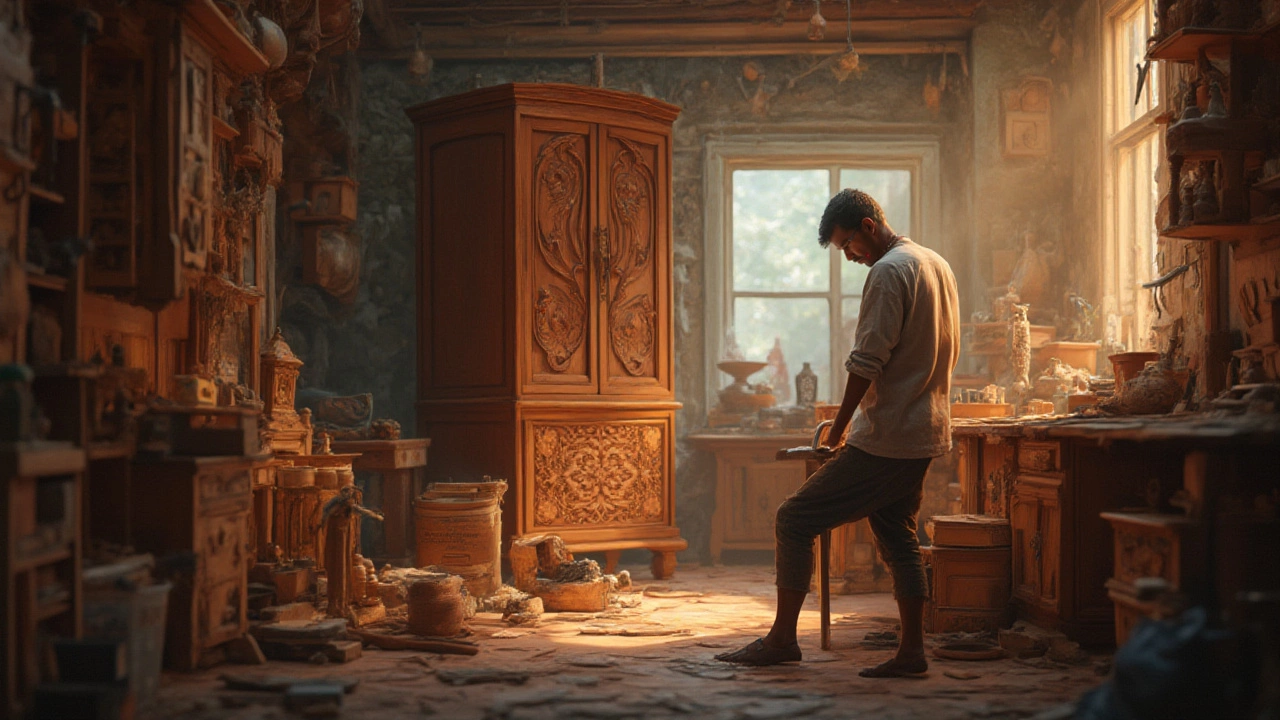You’re staring at a simple-looking wardrobe, maybe in a glossy catalogue or inside a breezy furniture showroom, when your jaw almost hits the floor. That sticker price? Way higher than you’d expect for, well, a big box with some doors. It’s almost laughable until you realize—you actually need one. The real kicker is, it’s not just the boutique brands or designer pieces driving up the numbers. Even the so-called 'budget' wardrobes don’t always feel so budget when you’re at the checkout. So, what’s hiding behind this sky-high cost? The answer isn’t as plain as flat-pack plywood. There’s a whole world happening behind those doors.
The Materials Dilemma: Not Just Wood and Screws
Walk into the jungle of wardrobe shopping, and you’ll quickly see materials matter—a lot. Sure, you can spot some that are pressed from particle board (basically wood dust glued together), but even those aren’t always as cheap as you'd expect. Why? It all starts with the global supply chain. Real, solid timber comes from slow-growing trees—oak, maple, ash—all of which need decades before they’re ready to be chopped down. Then there’s the cost of making sure forests are sustainably managed, which, honestly, adds up. Europe’s strict environmental regulations or Australia’s demand for eco-labels mean each plank gets traced and taxed at every turn.
Let’s say you find a wardrobe made of engineered wood. Particle board or MDF might be cheaper than solid oak, but they still require chemicals, adhesives, and manufacturing plants humming with machines. After the pandemic waves and 2024’s disruptions in shipping, these basic supplies got pricier worldwide. And don’t get me started on glass doors, mirrored panels, or fancy finishes. Tempered glass needs special kilns and skilled labor. High-gloss paint? Extra layers, more labor, more costs. Handles, rail systems, hinges—they all get blended in from different suppliers, each with their own markups.
Ever thought about the silent stuff? Safe adhesives and non-toxic treatments aren’t just for bragging rights. Regulations in the US and the EU limit formaldehyde and VOCs in household furniture, thanks to stricter health codes after a rash of furniture recalls in the late 2010s. These changes pushed factories to switch up their recipes, often to much pricier ingredients. So every piece, down to the most boring strip of backing board, gets scrutinized, signed off, and factored into that glowing price tag.
Design, Craftsmanship, and the Hours You Don’t See
Flip through any modern design magazine and you’ll see wardrobes that look almost artful—seamless sliders, soft-close drawers, hidden lighting. All those clean lines and smooth edges aren’t an accident. Good design takes time, and so do people. Whether your wardrobe is from a bespoke London joinery or a major Swedish flat-pack brand, someone spent months designing prototypes, testing hardware, and fiddling around with the best way to ship a three-meter-tall closet in a box a normal person can carry. Behind every new design, there’s a trail of discarded prototypes, small-batch runs, and focus groups pointing out what breaks or what people hate. That R&D isn’t free.
Then comes the actual labor. High-quality wardrobes use craftsmen who know wood like a chef knows his knife. Even mass-market wardrobes involve skilled workers running CNC machines, inspecting joints, and assembling demo models before anything hits the warehouse. Single custom wardrobes can soak up over fifty man-hours. Even factory-made wardrobes aren’t churned out like chocolate bars. Corners get fitted, shelves tested, and finishes polished—each step slows things down and raises the price.
Brand name plays in here, too. When you buy from names like Poliform, Calligaris, or even IKEA, you’re also paying for engineering, logistics, and all those stylized instruction booklets. These brands invest heavily in design competitions, marketing strategies, and customer-friendly return policies. Even lower-cost brands have to plow cash into making their wardrobes easy to assemble, safe to use, and, yes, somewhat attractive.

Shipping, Assembly, and the Hidden Costs of Getting It Home
Wardrobes are monsters to move. That’s not just because they’re heavy; even flat-packed, they’re awkward and take up a ton of space. Those shipping costs aren’t simply point A to B—they include warehouse storage, padded trucks, loading crews, and insurance at every stage, just in case something goes wrong in transit. A 2023 study in the UK’s furniture industry found shipping and storage made up nearly 20% of the final retail cost on large pieces like wardrobes.
Don’t forget about assembly. Some folks love spending a Saturday afternoon with an Allen key, but most dread the idea—especially if the wardrobe has dozens of panels, drawers, or a sliding rail system. If you’re not the DIY type, retailers often suggest professional assembly, which can run anywhere from $100 to $500 on top of the wardrobe price. And it’s not just because they want to upsell—it’s genuinely a beast for one person to wrangle into place. Safety is another hidden part. In the US, especially since the recall waves in 2022 for tip-prone wardrobes, big-name retailers started requiring wardrobes to include not just tip kits but wall brackets and special safety fittings. These cost money to design, test, and install correctly.
If you live up a flight of stairs or in a tighter space, those delivery costs grow. Some companies now offer white-glove delivery, which means delivery teams actually place your wardrobe where you want it, remove the packaging, and check all the bits before leaving. It might sound luxurious, but you’re paying for two or three experienced workers’ time. Let’s face it, that’s never cheap.
Style, Custom Options, and the Price of Choice
Wardrobes aren’t just storage—people want them to look good and fit their spaces. That means you’re rarely shopping for one-size-fits-all. The more custom you go, the pricier things get. Ever tried to order a wardrobe in a specific size, with eleven shoe drawers, three tie racks, and a mirrored finish? Every personalized tweak means designers revamp their drawings, factories change up the production line, and new materials are sourced for the one or two customers who want something different.
Sliding versus hinged doors. Built-in LED strips. Smart features like charging points or digital locks. Add-ons pile on cost quickly, because they aren’t always made in bulk. If a wardrobe maker only sells fifty units of a certain mirrored option per year, that mirrored panel is bought in tiny lots—which almost always costs more per piece. The cost of flexible production lines, custom-order fulfillment, and extra customer service? That gets baked into every so-called 'bespoke' wardrobe you see online or in the showroom. Some wardrobe makers hire in-house interior designers to help customers plan every shelf or cubby. Even basic consultation adds another layer to your bill.
Keep in mind: retailers often update collections every year or two to keep up with trends. Whenever a new color or hardware finish rolls out, it has to be tested for durability and appeal, and any leftover stock from older collections might get discounted, but the newer, trendier options always carry a premium—just like fresh sneakers or the latest smartphone model.

Tips to Get Quality Without Blowing Your Budget
So you want a great wardrobe but don’t want to sell a kidney to afford it. There are ways to save without ending up with a wobbly, wonky cupboard. First off, measure your space before you even start browsing—custom sizes skyrocket prices, while sticking to standard measurements usually opens more affordable choices. Second, give yourself time. Furniture sales don’t always line up with the seasons, but major holidays—think Black Friday or the January sales—see retailers slashing prices to clear out old stock. Don’t be shy about asking showrooms if they’ll discount floor models or imperfect stock with tiny dings or scratches. Those units are often just as sturdy, and dealers are happy to get rid of them without paying for return shipping or storage.
If you’re okay with a little DIY, flat-pack wardrobes are your friend. It may be a pain to assemble (get a buddy to help!), but you save big money on labor and shipping. Focus on quality for key components. Make sure shelves are thick enough to handle your stuff, doors open and close smoothly, and everything comes with tip-over safety kits. Don’t automatically splurge on extras like fancy lighting or memory foam inserts—add them later if you find you miss them.
Still craving custom flair? Many big-box wardrobe systems sell after-market options, so you can upgrade doors, handles, or storage boxes piece by piece as budget allows. And for a true bargain hunter move, check out online marketplaces for lightly used wardrobes—quality furniture can last for decades, but sometimes a paint job or new handles freshen up something tired for a fraction of the cost.
Last pro tip: ask about delivery and assembly up front. Sometimes retailers sneak those fees in right at checkout. If you’re feeling brave, local carpenters or small joiners can often build you tailored wardrobes for less than flagship designer rates—if you’re patient and like supporting local craft.
The next time someone gripes about wardrobes being overpriced, you’ll have the inside scoop. Between materials, design, shipping, and labor, these humble storage giants hide a money-devouring engine inside those double doors. But with a little strategy and some patience, you don’t have to pay more than you should for a solution that actually fits your life—and your bedroom.

